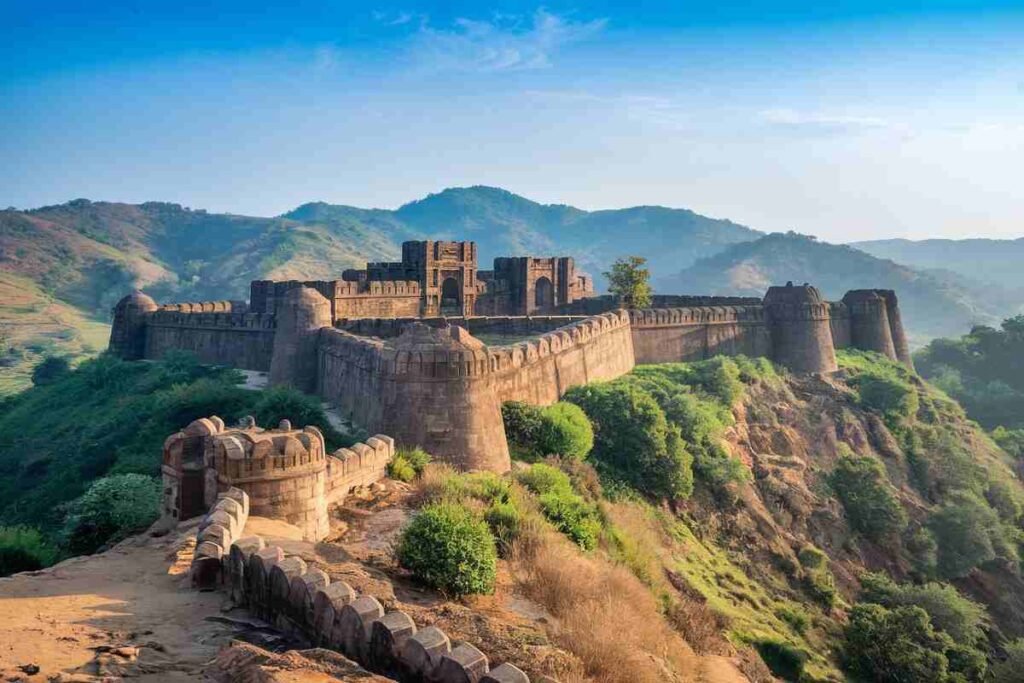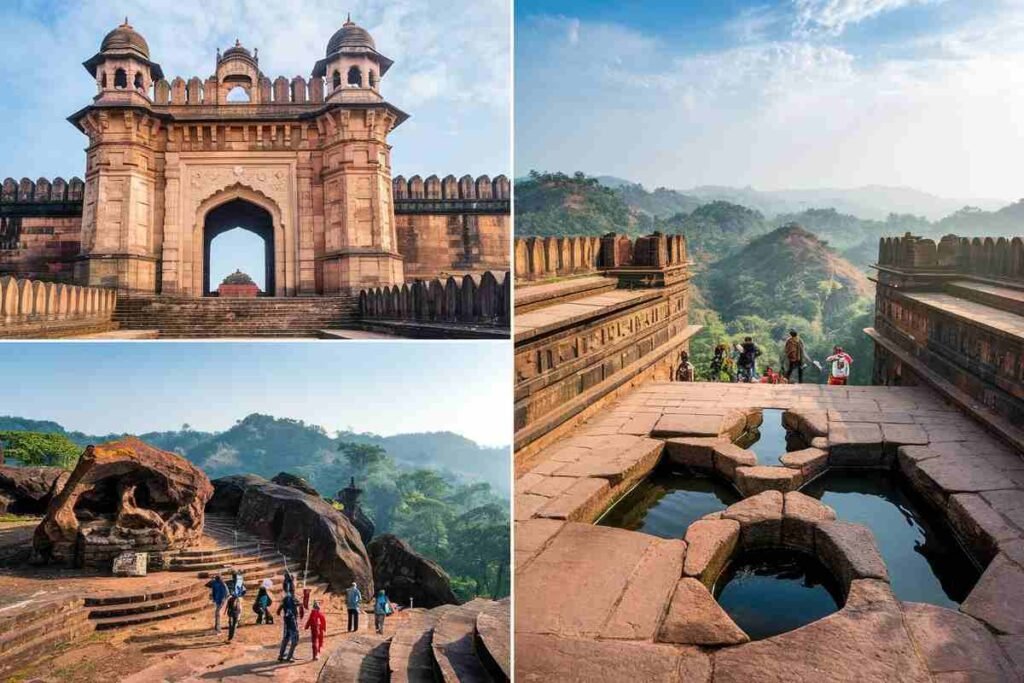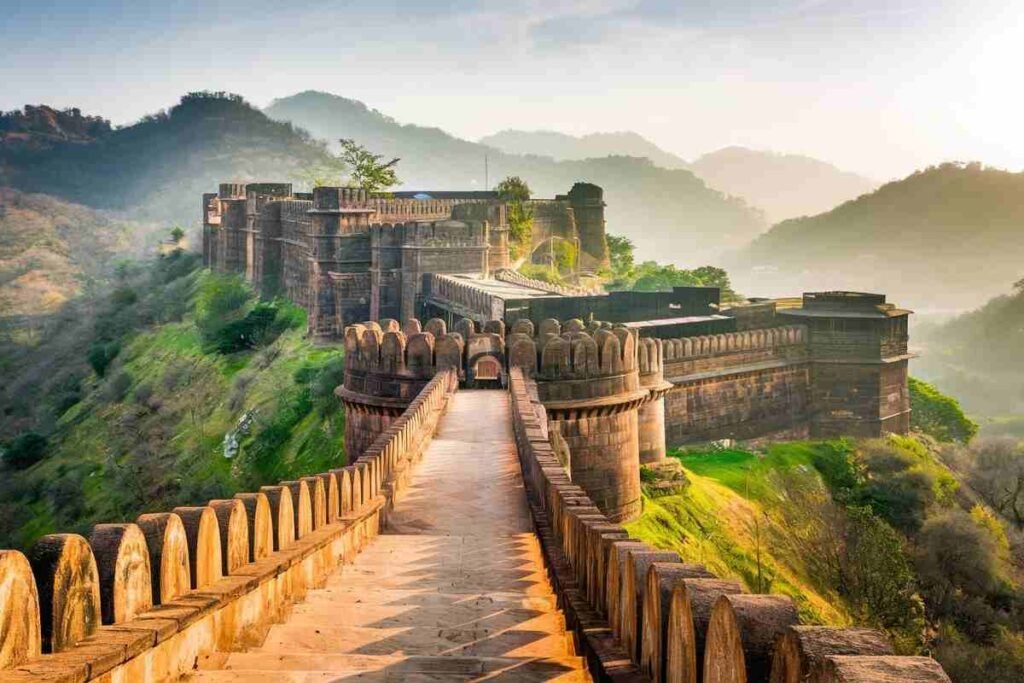Nestled in the scenic Sahyadri ranges, Rohida Fort is a must-visit for trekking enthusiasts. Known for its breathtaking views, historical significance, and thrilling yet moderate trek, it attracts adventure seekers and history buffs alike.
The fort offers a glimpse into Maharashtra’s rich heritage while rewarding visitors with panoramic landscapes.
Whether you’re a history buff or an adventure seeker, the trek to Rohida Fort promises a rewarding adventure amidst lush greenery, scenic landscapes, and breathtaking views.
What is Rohida Fort?

Rohida Fort, also referred to as Vichitragad, is located near Bhor in Maharashtra. This fort stands tall at an altitude of 3,665 feet above sea level, offering breathtaking views of the Sahyadri ranges.
Built during the Yadava dynasty and later reinforced by Shivaji Maharaj, Rohida-Fort holds immense historical significance.
The fort is famous for its ancient inscriptions, bastions, and the beautiful natural surroundings that make it an ideal trekking destination for beginners and seasoned adventurers alike.
Rohida Fort Trek Overview
The trek to Rohida-Fort is an exhilarating journey through the rugged landscapes of the Sahyadri ranges.
Whether you’re an experienced trekker or a beginner looking for a moderately challenging adventure, this trek provides a rewarding experience with stunning views, diverse terrains, and historical significance.
Trek Distance
The trek spans approximately 3 kilometers one way, making it an ideal short trek for a day outing.
The trail begins at Bajarwadi, the base village, and gradually ascends through a mix of terrains, including rocky paths, grassy patches, and forested areas.
- Time Required: The ascent usually takes around 1.5 to 2 hours, depending on your pace and fitness level.
- Trail Highlights: You’ll pass through a scenic route featuring lush greenery, especially during the monsoon, and enjoy the crisp air of the Sahyadri ranges.
The short distance combined with manageable difficulty makes this trek a popular choice for families, groups, and solo adventurers alike.
Rohida Fort Map
The Rohida Fort is a historical gem located in the Sahyadri range, offering a stunning trekking experience. Its map showcases key landmarks like bastions, water reservoirs, and ancient gates, making it an exciting journey for adventurers. The fort’s layout provides insight into its strategic importance during the Maratha era. Using a detailed Rohida Fort map helps visitors navigate its trails and discover hidden architectural marvels.
Rohida Fort Trek Difficulty Level
The Rohida Fort trek is classified as moderate, making it ideal for both beginners and experienced trekkers. While the ascent requires effort, the trail is manageable with proper preparation.
Key Challenges and Features:
Steep Sections: Some parts of the trail have a gradual incline, requiring stamina and balance.
Rocky Paths: Certain stretches feature uneven terrain, demanding careful footing, especially during monsoons.
Lush Greenery: Dense forest patches offer shade and scenic beauty but require attention to navigation.
Windy Plateaus: The fort’s open plateau areas provide breathtaking panoramic views but can be windy, requiring caution.
This trek offers a well-balanced challenge, making it an excellent choice for those looking to step up from beginner to moderate-level trekking.
Rohida Fort Height
Rohida Fort is perched at an impressive height of 3,665 feet (1,116 meters) above sea level, making it one of the prominent forts in the region.
Its elevated position offers stunning 360-degree views of the surrounding Sahyadri ranges, especially during clear weather.
- Panoramic Views: From the top, you can spot nearby forts such as Rajgad, Torna, and Sinhagad, which are equally significant in Maratha history.
- Best Time to Visit: During the monsoon, the fort is surrounded by mist and lush greenery, creating a magical atmosphere. In winter, the cool breeze and clear skies enhance the experience.
The height and location of the fort played a crucial role in its historical importance as a strategic watchpoint during the Maratha Empire.
Today, it serves as a vantage point for trekkers to soak in the beauty of Maharashtra’s rich natural and historical heritage.
How to Reach Rohida Fort
Reaching Rohida is relatively simple, whether you’re traveling by private vehicle or public transport.
Located about 75 kilometers from Pune, it serves as an ideal weekend destination for adventure and history enthusiasts. Below are the detailed travel options:
By Road
Traveling to Fort Rohida by road is one of the most convenient options, especially for those who prefer a flexible schedule.
- From Pune:
- Distance: The fort is approximately 75 kilometers from Pune.
- Route: Take the Pune-Bangalore Highway (NH 48) towards Bhor. From Bhor, proceed towards the base village of Bajarwadi, which is the starting point of the trek.
- Travel Time: The drive takes around 2 to 2.5 hours, depending on traffic.
- Parking: Ample parking space is available at Bajarwadi for private vehicles.
- From Mumbai:
- Distance: It is about 200 kilometers from Mumbai.
- Route: Follow the Mumbai-Pune Expressway to Pune, and then take the Pune-Bangalore Highway to Bhor.
- Travel Time: The journey typically takes around 4 to 5 hours.
Traveling by private car or a rented vehicle allows you to explore nearby attractions like Rajgad Fort and Torna Fort at your own pace.
By Public Transport
For those relying on public transport, reaching the fort involves a combination of bus and local vehicle travel:
- From Pune:
- State Transport Buses: Regular buses run from Swargate Bus Stand in Pune to Bhor town.
- Frequency: Buses are available at regular intervals, especially during the morning hours.
- Duration: The bus ride to Bhor takes around 2 to 2.5 hours.
- Cost: The ticket fare is affordable, making this a budget-friendly option.
- From Bhor to Bajarwadi:
- After reaching Bhor, you can hire local jeeps or shared rickshaws to cover the final 8-10 kilometers to Bajarwadi, the base village.
- Travel Time: This leg of the journey takes around 20–30 minutes.
- From Mumbai:
- Take a train or bus to Pune, and then follow the above-mentioned route to Bhor and Bajarwadi.
Pro Tips for Travelers
- Early Start: Begin your journey early in the morning to make the most of your trek and return comfortably.
- Local Transport Availability: If traveling by bus, ensure to check the availability of jeeps/rickshaws from Bhor, especially during off-peak seasons.
- Navigation: Use GPS to follow the route, as signboards may be limited in the rural areas near the base village.
- Fuel Up: If driving, ensure your vehicle has sufficient fuel as petrol pumps are scarce near Bhor and Bajarwadi.
Highlights of Rohida Fort
Historical Significance
Rohida Fort’s history dates back to the Yadava dynasty and later saw prominent use under Shivaji Maharaj.
It was a strategic fort during Shivaji’s reign, and its architectural elements reflect Maratha ingenuity. The fort’s bastions and rock-cut water cisterns still stand as symbols of its glorious past.
Scenic Views
The trek offers awe inspiring vistas of the Western Ghats, especially during the monsoon season when the surroundings turn lush green.
The fort also provides a clear view of neighboring peaks and forts.
Key Attractions at Rohida Fort

Main Entrance
The massive gates at Rohida Fort showcase traditional Maratha architecture. The carvings and design elements here are reminiscent of the fort’s historical legacy.
Bastions and Fortifications
The fort has six bastions, each offering unique perspectives of the surrounding landscape. These bastions were designed to defend the fort against enemy invasions.
Rock-Cut Cisterns
Several water cisterns carved into the rocks are still functional, showcasing the advanced water management systems of the past.
Temples
The fort houses a small temple dedicated to Lord Hanuman, a popular spot for trekkers to rest and enjoy the peaceful ambiance.
Tips for Trekking to Fort Rohida
Plan your Rohida Fort trek with the right gear, ideal timing, and safety precautions for a smooth and enjoyable adventure.
Best Time to Visit: The ideal seasons for trekking to Rohida Fort are monsoon and winter (June to February) when the weather is cool, and the surroundings are lush green, making the trek more enjoyable.
Essential Gear: Wear sturdy trekking shoes for grip, carry ample water, energy-boosting snacks, a first-aid kit, and a rain jacket if trekking during the monsoon.
Navigation & Guides: While the trail is well-marked, local guides from Bajarwadi village are available to assist first-time trekkers and share historical insights.
Safety Tips: Start early to avoid the midday heat, trek in groups for safety, and check the weather forecast before heading out.
With the right preparation, Rohida Fort offers an exhilarating trekking experience with stunning views and a touch of history!
Nearby Attractions
While visiting Rohida Fort, you can explore other nearby forts such as Rajgad Fort and Torna Fort, which are equally rich in history and trekking experiences.
Why Rohida Fort Should Be on Your List

Whether you’re a history buff, an adventure lover, or a nature enthusiast, this destination offers something for everyone.
Its moderate trek distance and difficulty level make it accessible for families and solo travelers. The rich history, coupled with mesmerizing views, ensures that your visit is both memorable and enriching.
Conclusion
Rohida Fort is not just a destination but an unforgettable experience that combines history, adventure, and the natural splendor of Maharashtra.
Whether you’re embarking on a moderate trek or soaking in the panoramic views from the top, the fort offers a chance to connect with nature and history in an unforgettable way.
With its rich legacy from the Yadava dynasty to Shivaji Maharaj’s reign, this fort stands as a testimony to Maharashtra’s cultural and historical grandeur. So, pack your essentials and get ready to conquer this hidden treasure—your adventure awaits!
FAQs
What is the height of Rohida-Fort?
Rohida Fort stands at a height of 3,665 feet above sea level.
How much time does it take to climb Rohida Fort?
It takes approximately 1.5 to 2 hours to climb Rohida Fort, depending on your pace and fitness level.
What is the history of Rohida Fort?
Rohida Fort, built during the Yadava dynasty and later reinforced by Shivaji Maharaj, served as a strategic Maratha stronghold.
Can we stay on Rohida Fort?
There are no proper accommodations on Rohida Fort, but trekkers can rest at the fort’s temple or nearby areas.
How to reach Rohida Fort?
Rohida Fort is accessible by road from Pune (75 km) or Mumbai (200 km), with the base village Bajarwadi as the starting point for the trek.
Who built the Purandar Fort?
Purandar Fort was built by the Yadava dynasty and later came under the control of Shivaji Maharaj.
How to reach Chittorgarh Fort by train?
Chittorgarh Fort can be reached by taking a train to Chittorgarh Railway Station, which is around 5 km from the fort.
What is the best time to visit Rohida Fort?
The best time to visit Rohida Fort is during the monsoon (June to September) or winter (October to February) for pleasant weather and lush greenery.


